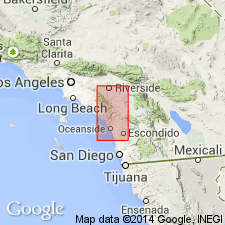
- Usage in publication:
-
- Domenigoni Valley granodiorite*
- Modifications:
-
- [Principal reference]
- Dominant lithology:
-
- Granodiorite
- AAPG geologic province:
-
- Peninsular Ranges province
Summary:
Pg. 69, pl. 1. Domenigoni Valley granodiorite. Underlies area of about 13 sq mi. Described as several bodies of rock that range in composition from tonalite to granodiorite. Crops out as light-colored boulders of disintegration. Resembles Bonsall tonalite but is lighter-colored and finer in grain size. Age is Cretaceous (on map legend). Derivation of name given. [Name Domenigoni granodiorite introduced by Larsen and Keevil (1947, GSA Bull., v. 58, no. 6, p. 488) in a report on a study of the batholith of southern California (GNU records, USGS DDS-6; Menlo GNULEX, Nov. 6, 1990).]
Named from exposures on both sides of Domenigoni Valley, southeastern part of Elsinore 30- by 60-min quadrangle, Riverside Co., CA.
Source: US geologic names lexicon (USGS Bull. 1200, p. 1136); supplemental information from GNU records (USGS DDS-6; Menlo GNULEX).
For more information, please contact Nancy Stamm, Geologic Names Committee Secretary.
Asterisk (*) indicates published by U.S. Geological Survey authors.
"No current usage" (†) implies that a name has been abandoned or has fallen into disuse. Former usage and, if known, replacement name given in parentheses ( ).
Slash (/) indicates name conflicts with nomenclatural guidelines (CSN, 1933; ACSN, 1961, 1970; NACSN, 1983, 2005, 2021). May be explained within brackets ([ ]).

